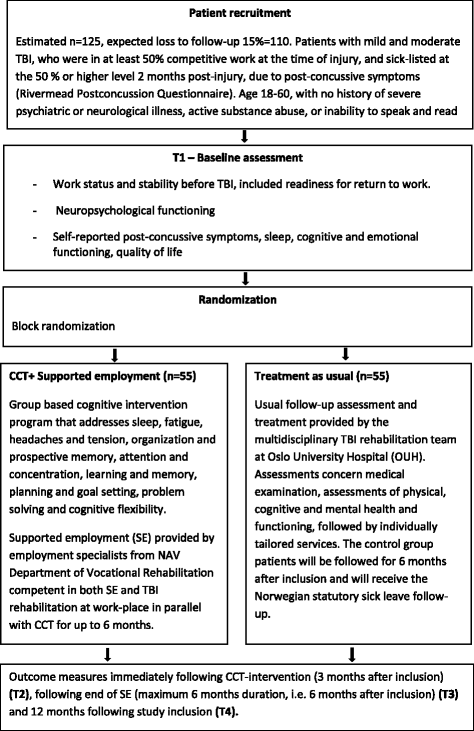Combined cognitive and vocational interventions after mild to moderate traumatic brain injury: study protocol for a randomized controlled trial
- PMID: 29041954
- PMCID: PMC5645893
- DOI: 10.1186/s13063-017-2218-7
Combined cognitive and vocational interventions after mild to moderate traumatic brain injury: study protocol for a randomized controlled trial
Abstract
Background: A considerable proportion of patients with mild to moderate traumatic brain injury (TBI) experience long-lasting somatic, cognitive, and emotional symptoms that may hamper their capacity to return to work (RTW). Although several studies have described medical, psychological, and work-related factors that predict RTW after TBI, well-controlled intervention studies regarding RTW are scarce. Furthermore, there has traditionally been weak collaboration among health-related rehabilitation services, the labor and welfare sector, and workplaces.
Methods/design: This study protocol describes an innovative randomized controlled trial in which we will explore the effect of combining manualized cognitive rehabilitation (Compensatory Cognitive Training [CCT]) and supported employment (SE) on RTW and related outcomes for patients with mild to moderate TBI in real-life competitive work settings. The study will be carried out in the southeastern region of Norway and thereby be performed within the Norwegian welfare system. Patients aged 18-60 years with mild to moderate TBI who are employed in a minimum 50% position at the time of injury and sick-listed 50% or more for postconcussive symptoms 2 months postinjury will be included in the study. A comprehensive assessment of neurocognitive function, self-reported symptoms, emotional distress, coping style, and quality of life will be performed at baseline, immediately after CCT (3 months after inclusion), following the end of SE (6 months after inclusion), and 12 months following study inclusion. The primary outcome measures are the proportion of participants who have returned to work at 12-month follow-up and length of time until RTW, in addition to work stability as well as work productivity over the first year following the intervention. Secondary outcomes include changes in self-reported symptoms, emotional and cognitive function, and quality of life. Additionally, a qualitative RTW process evaluation focused on organizational challenges at the workplace will be performed.
Discussion: The proposed study will combine cognitive and vocational rehabilitation and explore the efficacy of increased cross-sectoral collaboration between specialized health care services and the labor and welfare system. If the intervention proves effective, the project will describe the cost-effectiveness and utility of the program and thereby provide important information for policy makers. In addition, knowledge about the RTW process for persons with TBI and their workplaces will be provided.
Trial registration: ClinicalTrials.gov, NCT03092713 . Registered on 10 March 2017.
Keywords: Cognitive remediation; Disability management; Five-Step Process; Individual Placement and Support (IPS); Mild traumatic brain injury; Return to work; Supported employment; Work inclusion.
Conflict of interest statement
Ethical approval and consent to participate
The study has been presented to and approved by the Norwegian Regional Committee for Medical and Health Research Ethics (REK) (REK number 2016/2038). The project will be conducted according to the ethical guidelines of the Helsinki declaration. Information about the study will be presented to the patients in written and oral form. Written informed consent will be obtained, and the right to withdraw from the project at any time without any explanation necessary will be emphasized. All participants will be assigned an identification number, and all the questionnaires and datasets will be anonymized. Only the project team will have access to the document that links study identifiers with participant names.
Consent for publication
Not applicable.
Competing interests
The authors declare that they have no competing interests.
Publisher’s Note
Springer Nature remains neutral with regard to jurisdictional claims in published maps and institutional affiliations.
Figures


Similar articles
-
Cognitive and vocational rehabilitation after mild-to-moderate traumatic brain injury: A randomised controlled trial.Ann Phys Rehabil Med. 2021 Sep;64(5):101538. doi: 10.1016/j.rehab.2021.101538. Epub 2021 Jul 22. Ann Phys Rehabil Med. 2021. PMID: 33957293 Clinical Trial.
-
Effectiveness of Combining Compensatory Cognitive Training and Vocational Intervention vs. Treatment as Usual on Return to Work Following Mild-to-Moderate Traumatic Brain Injury: Interim Analysis at 3 and 6 Month Follow-Up.Front Neurol. 2020 Nov 10;11:561400. doi: 10.3389/fneur.2020.561400. eCollection 2020. Front Neurol. 2020. PMID: 33240196 Free PMC article.
-
A manual-based vocational rehabilitation program for patients with an acquired brain injury: study protocol of a pragmatic randomized controlled trial (RCT).Trials. 2017 Aug 10;18(1):371. doi: 10.1186/s13063-017-2115-0. Trials. 2017. PMID: 28793916 Free PMC article. Clinical Trial.
-
Scoping review of return-to-work interventions for persons with traumatic brain injury.Disabil Rehabil. 2024 Jul;46(15):3243-3255. doi: 10.1080/09638288.2023.2243583. Epub 2023 Aug 8. Disabil Rehabil. 2024. PMID: 37551864
-
Return to work following traumatic brain injury: trends and challenges.Disabil Rehabil. 2007 Sep 15;29(17):1387-95. doi: 10.1080/09638280701315011. Disabil Rehabil. 2007. PMID: 17729084 Review.
Cited by
-
Exploring the Association between Personality Traits, Symptom Burden, and Return to Work after Mild-to-Moderate Traumatic Brain Injury.J Clin Med. 2023 Jul 13;12(14):4654. doi: 10.3390/jcm12144654. J Clin Med. 2023. PMID: 37510769 Free PMC article.
-
The Neurobiological Links between Stress and Traumatic Brain Injury: A Review of Research to Date.Int J Mol Sci. 2022 Aug 23;23(17):9519. doi: 10.3390/ijms23179519. Int J Mol Sci. 2022. PMID: 36076917 Free PMC article. Review.
-
Psychological Intervention in Traumatic Brain Injury Patients.Behav Neurol. 2019 May 2;2019:6937832. doi: 10.1155/2019/6937832. eCollection 2019. Behav Neurol. 2019. PMID: 31191738 Free PMC article. Review.
-
Return to work after critical illness: a systematic review and meta-analysis.Thorax. 2020 Jan;75(1):17-27. doi: 10.1136/thoraxjnl-2019-213803. Epub 2019 Nov 8. Thorax. 2020. PMID: 31704795 Free PMC article.
-
The importance of behavioral interventions in traumatic brain injury.Surg Neurol Int. 2024 Jan 26;15:22. doi: 10.25259/SNI_776_2023. eCollection 2024. Surg Neurol Int. 2024. PMID: 38344079 Free PMC article. Review.
References
Publication types
MeSH terms
Associated data
LinkOut - more resources
Full Text Sources
Other Literature Sources
Medical

